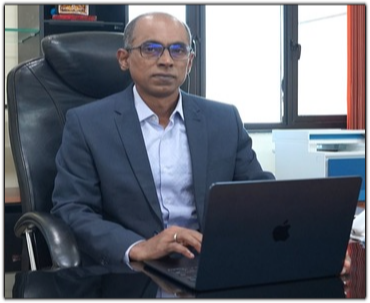
Prof. Ganesan Karthikeyan
Executive Director
A new beginning
I am acutely aware of our shrinking attention spans particularly when it comes to staid “messages” on webpages! So, I am just going to keep this very short, just enough to pique your interest and get you to explore our website.
At the outset, to give credit where it is due, much of our work is a legacy of our previous leadership including that of my beloved mentor and friend, Prof Pramod Garg. Thanks, are also due to the Honorable Minister of Science and Technology Dr Jitendra Singh, and Dr Rajesh Gokhale, Secretary DBT, who continue to be incredibly supportive with their time and advice.
For those of you who are familiar with THSTI, you will notice that this year, we have pivoted decisively towards translating fundamental leads to clinically useful products. We recognize that industry has critical role to play in translating innovations from academia to clinical practice. To this end, we organized an industry outreach meeting, aptly named SYNCHN, to showcase our scientific strengths. This was a first of its kind event and I am happy to report that this outreach resulted in over a dozen collaborations with industry in key areas of diagnostics and therapeutics. We propose to have a much larger SYNCHN this year with international players participating.
One of our key areas of strength remains virus biology and therapeutics. As a testament to THSTI’s contribution during the pandemic, we have now become part of the World Health Organization’s (WHO) CoViNet Reference Laboratories for surveillance, tracking, and testing coronaviruses (News). Building on our earlier success with robust Dengue NS1 assays, our scientists have now generated a large repertoire of monoclonal antibodies against Chikungunya virus E1/E2 antigens and Zika virus NS1 antigen. These tools will be critical for developing antigen detection tests for Zika and Chikungunya, as no such tests are currently available in the market. I would like to highlight two exciting developments that are likely to have major implications to global public health in the coming year. First, our scientists have developed two vaccine candidates against Mpox which have already entered an accelerated phase of development in collaboration with industry partners. Second, highly specific, strongly neutralizing monoclonal antibodies against the deadly Nipah virus are also in an accelerated phase of development.
Other major works with translational potential include the development of AI-based imaging tools to accurately estimate gestational age (News IITM GARBHIni). This will have public health implications as this is the first tool based on Indian mothers and is likely to replace the existing method of gestational age estimation which is based on a Caucasian population. Our researchers working on the human microbiome have developed live biotherapeutics that show promise in the treatment of obesity and other metabolic diseases. We have also created a repository of genetically characterized microbial repository which will be of immense value for research on antimicrobial resistance.
New infrastructure to support our translational efforts are rapidly being readied. The Medical Research Facility is nearly ready and is likely to be inaugurated early next year (MRC Research facility). This will house the Centre of Excellence for Cell Therapy Research, a clinical pharmacology unit, and a facility for performing controlled human infection studies. The existing Experimental Animal Facility has been upgraded to a world-class one with advanced imaging, histopathology and breeding capabilities (EAF Research facility). During 2023-24, THSTI launched the School of Innovation in Biodesign (SiB) to promote entrepreneurship, making it the only DBT Institution to provide such training.
If this introduction to our triumphs and plans for the future has made you want to know more about us, and explore avenues for collaboration, I would have succeeded in my task as the chronicler of our scientists’ work.
Prof Ganesan Karthikeyan
Executive Director
